Future Changes of Precipitation over the Han River Basin Using NEX-GDDP Dataset and the SVR_QM Method
Abstract
1. Introduction
2. Materials and Methods
2.1. Study Area and Data
2.2. Methodology
2.2.1. Data Preprocessing
2.2.2. Selecting the Superior Ensemble Method from MLP, SVR, and RF
2.2.3. Combining the SVR and QM Methods
2.2.4. Evaluation and Projection for SVR_QM
3. Results and Discussion
3.1. Validation and Comparison of the Machine Learning Ensemble Models
3.2. Validation of SVR_QM Method
3.3. Projected Precipitation in the Han River Basin during the 21st Century under RCP4.5 and 8.5
4. Conclusions
- (1)
- The raw precipitation simulation of individual NEX-GDDP models had a certain reliability for the Han River basin—the PCC was 0.61–0.71, and RMSE was approximately 48–51 mm. The results of three ML methods and MME all demonstrated their superiority over all individual NEX-GDDP models—the PCC improved to 0.77–0.81, and RMSE was 34–37 mm. The ML performed better than MME. Overall, the SVR showed the best performance—PCC was up to 0.81, and RMSE was up to 34.52 mm. For each station, there were similar conclusions on the whole, although there were less contrary ones for several stations. However, the different performance of each station was obvious. This may have been due to the influence of the raw data, model uncertainty, and especially the local climate.
- (2)
- The application of the QM method for the results of SVR models demonstrated the further improvement of the simulation reliability. Although there were some improvements for PCC and RMSE, Rbias was obviously alleviated compared with MME, MLP, SVR, and RF. The Rbias values were reduced to −2.04–0.36% for each station and −0.04% for the region mean. The best models established on the basis of historic series could improve the reliability of projected precipitation.
- (3)
- The changes of precipitation during the 21st century in this region had a very significantly increasing trend under RCP4.5 and RCP8.5, whereas there was a slight decreasing fluctuation in the period of 2006–2040. More specifically, compared with the base years, the regional average precipitation during the middle and late 21st century increased by 3.54% and 5.12% under RCP45 and by 7.44% and 9.52% under RCP8.5, respectively. In addition, it can be concluded that the increasing trends existed among most stations under RCP4.5 and RCP8.5, and most of these cases were also significant. These results were expected to be used for the guidance of more accurate long-term management strategies such as water resource allocation, flood mitigation, and ecological layout, among others.
Supplementary Materials
Author Contributions
Funding
Acknowledgments
Conflicts of Interest
Appendix A
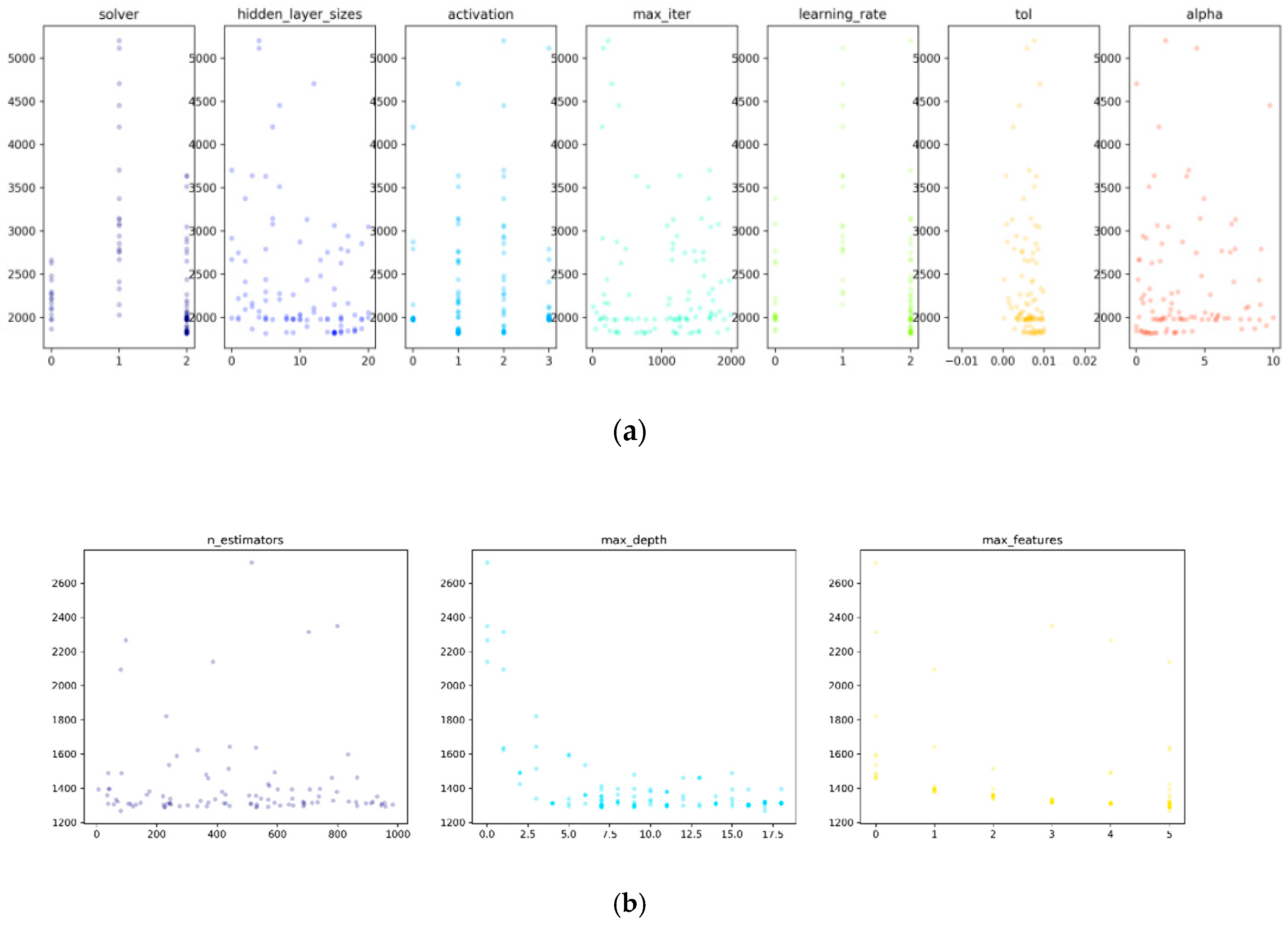
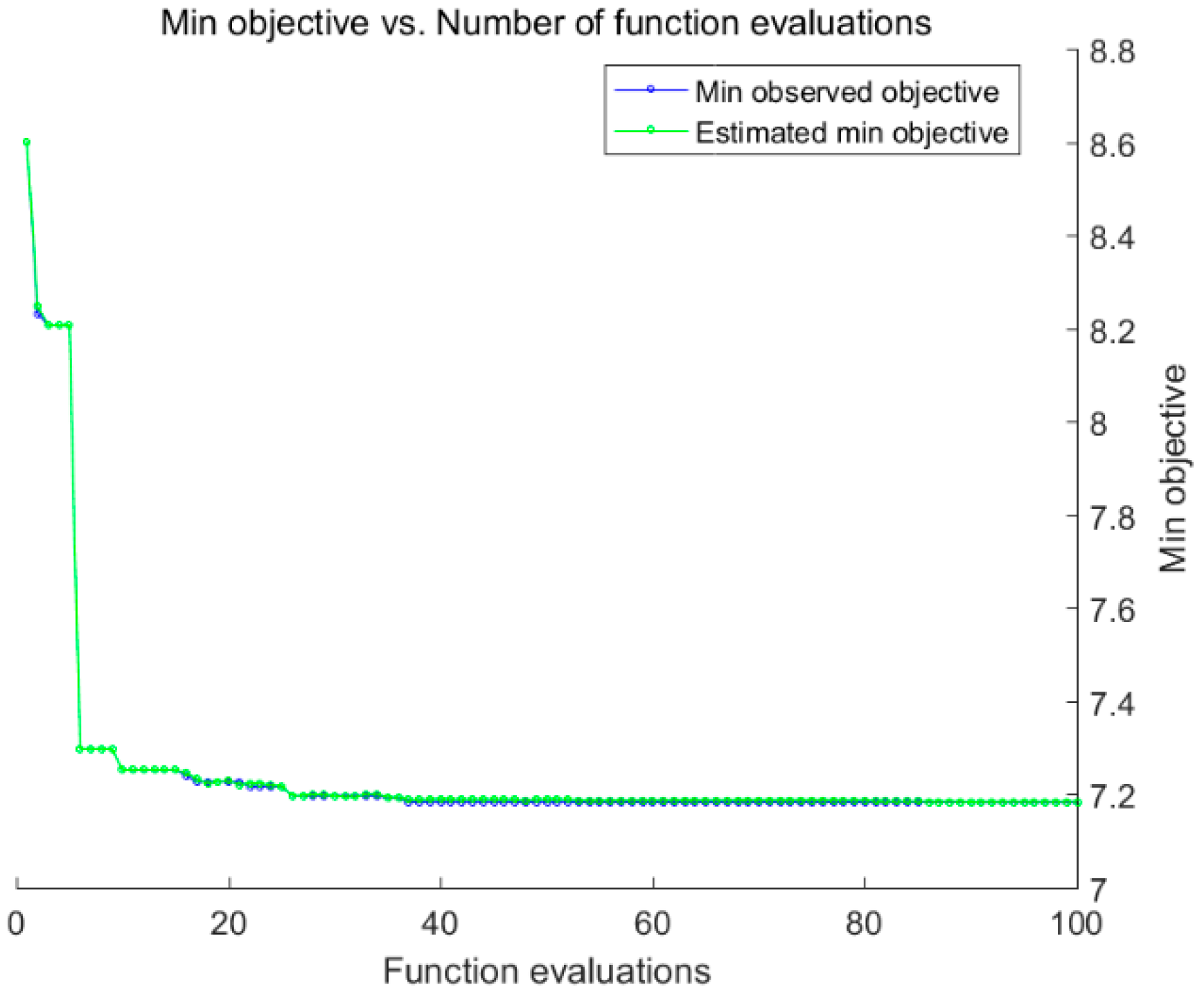
Appendix B
| Activation | Alpha | HLZ | LR | Max_Iter | Solver | Toleration | Objective | |
|---|---|---|---|---|---|---|---|---|
| 1 | logistic | 0.38893 | 21 | invscaling | 1716 | adam | 0.0094 | 7159 |
| 2 | logistic | 9.36822 | 25 | adaptive | 1746 | sgd | 0.008504 | 4603 |
| 3 | logistic | 3.208232 | 19 | constant | 1662 | adam | 0.001292 | 5616 |
| 4 | relu | 8.771009 | 28 | adaptive | 1365 | adam | 0.00382 | 3510 |
| 5 | tanh | 9.897623 | 22 | adaptive | 1073 | sgd | 0.003672 | 4105 |
| 6 | tanh | 9.637579 | 24 | adaptive | 1928 | adam | 0.003242 | 2627 |
| 7 | relu | 3.943412 | 8 | constant | 122 | sgd | 0.007766 | 1748 |
| 8 | tanh | 9.515672 | 17 | invscaling | 1880 | adam | 0.00996 | 3413 |
| 9 | logistic | 9.648305 | 22 | constant | 1333 | adam | 0.008567 | 2920 |
| 10 | logistic | 9.5028 | 18 | constant | 740 | sgd | 0.000971 | 2241 |
| 11 | logistic | 1.622979 | 19 | invscaling | 1570 | adam | 0.005583 | 2376 |
| 12 | relu | 5.241334 | 25 | constant | 1731 | adam | 0.009118 | 3236 |
| 13 | tanh | 5.085167 | 21 | adaptive | 1552 | sgd | 0.005805 | 2862 |
| 14 | logistic | 8.695285 | 24 | adaptive | 114 | sgd | 0.008918 | 4095 |
| 15 | relu | 5.981711 | 13 | constant | 1868 | adam | 0.008298 | 2793 |
| 16 | tanh | 5.299041 | 29 | constant | 1843 | adam | 0.001989 | 2168 |
| 17 | relu | 5.81592 | 20 | adaptive | 1462 | adam | 0.002042 | 2847 |
| 18 | relu | 2.623849 | 15 | invscaling | 1973 | sgd | 0.005537 | 2729 |
| 19 | tanh | 9.003359 | 21 | adaptive | 1520 | adam | 0.005904 | 2825 |
| 20 | tanh | 9.220402 | 25 | invscaling | 1140 | adam | 0.007081 | 1659 |
| 21 | tanh | 2.950731 | 23 | adaptive | 1278 | sgd | 0.002721 | 1790 |
| mean | tanh | 4.394055 | 17 | invscaling | 1006 | sgd | 0.001451 | 1288 |
| Max_Depth | Max_Features | N_Estimators | Objective | |
|---|---|---|---|---|
| 1 | 6 | 8 | 55 | 6870 |
| 2 | 4 | 5 | 429 | 4634 |
| 3 | 7 | 8 | 87 | 5486 |
| 4 | 5 | 8 | 376 | 3589 |
| 5 | 7 | 8 | 547 | 4044 |
| 6 | 10 | 5 | 314 | 2562 |
| 7 | 11 | 7 | 474 | 1735 |
| 8 | 18 | 4 | 91 | 3456 |
| 9 | 15 | 4 | 435 | 2878 |
| 10 | 11 | 6 | 56 | 2292 |
| 11 | 5 | 7 | 226 | 2360 |
| 12 | 7 | 6 | 146 | 3265 |
| 13 | 14 | 5 | 144 | 3012 |
| 14 | 17 | 4 | 122 | 4306 |
| 15 | 13 | 4 | 371 | 2888 |
| 16 | 5 | 7 | 312 | 2238 |
| 17 | 7 | 8 | 219 | 2883 |
| 18 | 7 | 8 | 266 | 2770 |
| 19 | 11 | 4 | 466 | 2808 |
| 20 | 14 | 7 | 311 | 1673 |
| 21 | 11 | 8 | 90 | 1762 |
| mean | 16 | 8 | 95 | 1304 |
| Station | Box Constraint | Kernel Scale | Epsilon | Kernel Function | Polynomial Order | Standardize | Objective |
|---|---|---|---|---|---|---|---|
| 1 | 44.83 | 156.48 | 0.48647 | Gaussian | NaN | false | 8.6212 |
| 2 | 112.87 | 70.445 | 2.3872 | Gaussian | NaN | false | 8.1288 |
| 3 | 83.342 | 112.34 | 0.3045 | Gaussian | NaN | false | 8.1611 |
| 4 | 89.157 | 28.709 | 0.089533 | Gaussian | NaN | false | 8.3211 |
| 5 | 22.734 | 19.574 | 0.48647 | Gaussian | NaN | true | 7.8536 |
| 6 | 103.68 | NaN | 0.8746 | Polynomial (rbf) | 2 | true | 7.4314 |
| 7 | 203.68 | NaN | 0.30124 | Polynomial (rbf) | 2 | true | 7.406 |
| 8 | 353.41 | 124.223 | 0.33471 | gaussian | NaN | true | 7.9878 |
| 9 | 18.997 | NaN | 2.8774 | Polynomial | 2 | true | 7.6882 |
| 10 | 332.85 | NaN | 1.38503 | Polynomial | 2 | True | 7.7515 |
| 11 | 78.679 | 50.432 | 0.8879 | Gaussian | NaN | false | 8.0716 |
| 12 | 189.78 | 155.84 | 1.8994 | Gaussian | NaN | true | 7.9665 |
| 13 | 263.56 | 8.1846 | 0.054217 | gaussian | NaN | true | 8.3216 |
| 14 | 247.22 | 88.6911 | 0.54884 | gaussian | NaN | true | 7.9045 |
| 15 | 371.78 | 102.8722 | 0.04587 | gaussian | NaN | true | 7.9458 |
| 16 | 167.88 | 23.685 | 0.1066 | gaussian | NaN | true | 7.6972 |
| 17 | 53.297 | 3.6386 | 0.75566 | gaussian | NaN | false | 7.9461 |
| 18 | 594.16 | 27.898 | 0.38872 | gaussian | NaN | false | 7.8806 |
| 19 | 288.76 | NaN | 0.78661 | Polynomial | 2 | True | 7.8977 |
| 20 | 610.87 | 32.538 | 1.6156 | gaussian | NaN | false | 7.4072 |
| 21 | 412.66 | NaN | 1.1667 | Polynomial | 2 | True | 7.5092 |
| mean | 305.46 | 45.025 | 1.0788 | gaussian | NaN | true | 7.1463 |
Appendix C
References
- Mann, M.E.; Rahmstorf, S.; Kornhuber, K.; Steinman, B.A.; Miller, S.K.; Coumou, D. Influence of anthropogenic climate change on planetary wave resonance and extreme weather events. Sci. Rep. 2017, 7, 45242. [Google Scholar] [CrossRef] [PubMed]
- Naveendrakumar, G.; Vithanage, M.; Kwon, H.H.; Chandrasekara, S.S.K.; Iqbal, M.C.M.; Pathmarajah, S.; Obeysekera, J. South Asian perspective on temperature and rainfall extremes: A review. Atmos. Res. 2019, 225, 110–120. [Google Scholar] [CrossRef]
- Moncrieff, M.W.; Liu, C.; Bogenschutz, P. Simulation, modeling, and dynamically based parameterization of organized tropical convection for global climate models. J. Atmos. Sci. 2017, 74, 1363–1380. [Google Scholar] [CrossRef]
- Farjad, B.; Gupta, A.; Sartipizadeh, H.; Cannon, A.J. A novel approach for selecting extreme climate change scenarios for climate change impact studies. Sci. Total Environ. 2019, 678, 476–485. [Google Scholar] [CrossRef] [PubMed]
- Abbasian, M.; Moghim, S.; Abrishamchi, A. Performance of the general circulation models in simulating temperature and precipitation over Iran. Theor. Appl. Climatol. 2019, 135, 1465–1483. [Google Scholar] [CrossRef]
- Rashid, M.; Jia, S.F.; Nitin, K.T.; Sangam, S. Precipitation Extended Linear Scaling Method for Correcting GCM Precipitation and Its Evaluation and Implication in the Transboundary Jhelum River Basin. Atmosphere 2018, 9, 160. [Google Scholar] [CrossRef]
- Yhang, Y.B.; Sohn, S.J.; Jung, I.W. Application of Dynamical and Statistical Downscaling to East Asian Summer Precipitation for Finely Resolved Datasets. Adv. Meteorol. 2017, 2017, 2956373. [Google Scholar] [CrossRef]
- Shin, Y.; Yi, C. Statistical Downscaling of Urban-scale Air Temperatures Using an Analog Model Output Statistics Technique. Atmosphere 2019, 10, 427. [Google Scholar] [CrossRef]
- Jain, S.; Salunke, P.; Mishra, S.K. Advantage of NEX-GDDP over CMIP5 and CORDEX Data: Indian Summer Monsoon. Atmos. Sci. 2019, 228, 152–160. [Google Scholar] [CrossRef]
- Chen, H.P.; Sun, J.Q.; Li, H.X. Future changes in precipitation extremes over China using the NEX-GDDP high-resolution daily downscaled data-set. Atmos. Ocean. Sci. Lett. 2017, 10, 403–410. [Google Scholar] [CrossRef]
- Raghavan, S.V.; Hur, J.; Liong, S.Y. Evaluations of NASA NEX-GDDP data over Southeast Asia: Present and future climates. Clim. Chang. 2018, 148, 503–518. [Google Scholar] [CrossRef]
- Knutti, R.; Furrer, R.; Tebaldi, C.; Cermak, J.; Meehl, G.A. Challenges in Combining Projections from Multiple Climate Models. J. Clim. 2010, 23, 2739–2758. [Google Scholar] [CrossRef]
- Tebaldi, C.; Smith, R.L.; Nychka, D. Quantifying uncertainty in projections of regional climate change: A Bayesian approach to the analysis of multimodel ensembles. J. Clim. 2005, 18, 1524–1540. [Google Scholar] [CrossRef]
- Li, J.; Yang, Y.M.; Wang, B. Evaluation of NESMv3 and CMIP5 Models’ Performance on Simulation of Asian-Australian Monsoon. Atmosphere 2018, 9, 327. [Google Scholar] [CrossRef]
- Mosavi, A.; Ozturk, P.; Chau, K.W. Flood Prediction Using Machine Learning Models: Literature Review. Water 2018, 10, 1536. [Google Scholar] [CrossRef]
- Ochoa, A.; Campozano, L.; S´anchez, E.; Gual´an, R.; Samaniego, E. Evaluation of downscaled estimates of monthly temperature and precipitation for a Southern Ecuador case study. Int. J. Climatol. 2015, 36, 1244–1255. [Google Scholar] [CrossRef]
- Vapnik, V. The Nature of Statistical Learning Theory, 2nd ed.; Information Science and Statistics; Springer-Verlag: New York, NY, USA, 2000; ISBN 978-0-387-98780-4. [Google Scholar]
- Sachindra, D.A.; Ahmed, K.; Rashid, M.M.; Shahid, S.; Perera, B.J.C. Statistical downscaling of precipitation using machine learning techniques. Atmos. Res. 2018, 212, 240–258. [Google Scholar] [CrossRef]
- Najafi, M.R.; Moradkhani, H.; Wherry, S.A. Statistical Downscaling of Precipitation Using Machine Learning with Optimal Predictor Selection. J. Hydrol. Eng. 2011, 16, 650–664. [Google Scholar] [CrossRef]
- Sa’adi, Z.; Shahid, S.; Chung, E.S.; Ismail, T.B. Projection of spatial and temporal changes of rainfall in Sarawak of Borneo Island using statistical downscaling of CMIP5 models. Atmos. Res. 2017, 197, 446–460. [Google Scholar] [CrossRef]
- Rashid, M.; Beecham, S.; Chowdhury, R. Simulation of extreme rainfall from CMIP5 in the Onkaparinga catchment using a generalized linear model. In Proceedings of the MODSIM2013, 20th International Congress on Modelling and Simulation. Modelling and Simulation Society of Australia and New Zealand, Adelaide, Australia, 1–6 December 2013; pp. 2520–2526. [Google Scholar]
- Rashid, M.M.; Beechama, S.; Chowdhury, R.K. Statistical downscaling of CMIP5 outputs for projecting future changes in rainfall in the Onkaparinga catchment. Sci. Total Environ. 2015, 530–531, 171–182. [Google Scholar] [CrossRef]
- Xu, L.; Chen, N.C.; Zhang, X.; Chen, Z.Q.; Hu, C.L.; Wang, C. Improving the North American multi-model ensemble (NMME) precipitation forecasts at local areas using wavelet and machine learning. Clim. Dyn. 2019, 53, 601–615. [Google Scholar] [CrossRef]
- Shukla, A.K.; Ojha, C.S.P.; Singh, R.P.; Pal, L.; Fu, D.F. Evaluation of TRMM Precipitation Dataset over Himalayan Catchment: The Upper Ganga Basin, India. Water 2019, 11, 613. [Google Scholar] [CrossRef]
- Hamill, T.M.; Scheuerer, M. Probabilistic Precipitation Forecast Postprocessing Using Quantile Mapping and Rank-Weighted Best-Member Dressing. Mon. Weather Rev. 2018, 164, 4079–4098. [Google Scholar] [CrossRef]
- Themeßl, M.J.; Gobiet, A.; Leuprecht, A. Empirical-statistical downscaling and error correction of daily precipitation from regional climate models. Int. J. Climatol. 2011, 31, 1530–1544. [Google Scholar] [CrossRef]
- The Website of China Meteorological Data. Available online: http://data.cma.cn/ (accessed on 12 February 2019).
- Thrasher, B.; Xiong, J.; Wang, W.; Melton, F.; Michaelis, A.; Nemani, R. Downscaled Climate Projections Suitable for Resource Management. Eos Trans. Am. Geophys. Union 2011, 94, 321–323. [Google Scholar] [CrossRef]
- The Website of NEX Global Daily Downscaled Climate Projections. Available online: https://nex.nasa.gov/nex/projects/1356/ (accessed on 22 March 2019).
- Hotelling, H. Analysis of a Complex of Statistical Variables into Principal Components. J. Educ. Psychol. 1993, 24, 417. [Google Scholar] [CrossRef]
- Minsky, M.; Seymour, P. Perceptron: An Introduction to Computational Geometry; The MIT Press: Cambridge, MA, USA, 1969; Volume 88, p. 2. [Google Scholar]
- Rumelhart, D.E.; Geoffrey, E.H.; Ronald, J.W. Learning Internal Representations by Error Propagation; No. ICS-8506; California Univ San Diego La Jolla Inst for Cognitive Science: La Jolla, CA, USA, 1985. [Google Scholar]
- Kim, T.W.; Valdés, J.B. Nonlinear Model for Drought Forecasting Based on a Conjunction of Wavelet Transforms and Neural Networks. J. Hydrol. Eng. 2003, 8, 319–328. [Google Scholar] [CrossRef]
- Tripathi, S.; Srinivas, V.V.; Nanjundiah, R.S. Dowinscaling of precipitation for climate change scenarios: A support vector machine approach. J. Hydrol. 2006, 330, 621–640. [Google Scholar] [CrossRef]
- Pour, S.H.; Shahid, S.; Chung, E.S.; Wang, X.J. Model output statistics downscaling using support vector machine for the projection of spatial and temporal changes in rainfall of Bangladesh. Atmos. Res. 2018, 213, 149–162. [Google Scholar] [CrossRef]
- Breiman, L. Random Forests. Mach. Learn. 2001, 45, 5–32. [Google Scholar] [CrossRef]
- Breiman, L.; Friedman, J.; Stone, C.J.; Olshen, R.A. Classification and Regression Trees; CRC Press: Borarton, FL, USA, 1984. [Google Scholar]
- Maier, H.R.; Dandy, G.C. Neural networks for the prediction and forecasting of water resources variables: A review of modelling issues and applications. Environ. Model. Softw. 2000, 15, 101–124. [Google Scholar] [CrossRef]
- Xia, Y.F.; Liu, C.Z.; Li, Y.Y.; Liu, N.N. A boosted decision tree approach using Bayesian hyper-parameter optimization for credit scoring. Expert Syst. Appl. 2017, 78, 225–241. [Google Scholar] [CrossRef]
- Bergstra, J.S.; Bardenet, R.; Bengio, Y.; Kégl, B. Algorithms for hyper-parameter optimization. In Advances in Neural Information Processing Systems; Mit Press: Cambridge, MA, USA, 2011; pp. 2546–2554. [Google Scholar]
- Cannon, A.J.; Sobie, S.R.; Murdock, T.Q. Bias Correction of GCM Precipitation by Quantile Mapping: How Well Do Methods Preserve Changes in Quantiles and Extremes? J. Clim. 2015, 28, 6938–6959. [Google Scholar] [CrossRef]
- Whan, K.; Schmeits, M.C. Comparing Area Probability Forecasts of (Extreme) Local Precipitation Using Parametric and Machine Learning Statistical Postprocessing Methods. Mon. Weather Rev. 2018, 146, 3651–3673. [Google Scholar] [CrossRef]
- Wang, W.G.; Ding, Y.M.; Shao, Q.X.; Xu, J.Z.; Jiao, X.Y.; Luo, Y.F.; Yu, Z.B. Bayesian multi-model projection of irrigation requirement and water use efficiency in three typical rice plantation region of China based on CMIP5. Agric. For. Meteorol. 2017, 232, 89–105. [Google Scholar] [CrossRef]
- Mann, H. Non-parametric tests against trend. Econometrica 1945, 13, 245–259. [Google Scholar] [CrossRef]
- Kendall, M. Rank Correlation Methods, 4th ed.; Charles Griffin& Co. Ltd.: London, UK, 1975. [Google Scholar]
- Dinpashoh, Y.; Jahanbakhsh-Asl, S.; Rasouli, A.A.; Foroughi, M.; Singh, V.P. Impact of climate change on potential evapotranspiration (case study: West and NW of Iran). Theor. Appl. Climatol. 2019, 136, 185. [Google Scholar] [CrossRef]
- Kang, B.; Moon, S. Regional hydroclimatic projection using an coupled composite downscaling model with statistical bias corrector. KSCE J. Civ. Eng. 2017, 21, 2991–3002. [Google Scholar] [CrossRef]
- Ding, Y.M.; Wang, W.G.; Song, R.M.; Shao, Q.X.; Jiao, X.Y.; Xing, W.Q. Modeling spatial and temporal variability of the impact of climate change on rice irrigation water requirements in the middle and lower reaches of the Yangtze River, China. Agric. Water Manag. 2017, 193, 89–101. [Google Scholar] [CrossRef]
- Raziei, T. An analysis of daily and monthly precipitation seasonality and regimes in Iran and the associated changes in 1951–2014. Theor. Appl. Climatol. 2018, 134, 913–934. [Google Scholar] [CrossRef]
- Moron, V.; Robertson, A.W.; Ward, M.N.; Ndiaye, O. Weather types and rainfall over Senegal. Part II: Downscaling of GCM simulations. J. Clim. 2008, 21, 288–307. [Google Scholar] [CrossRef]
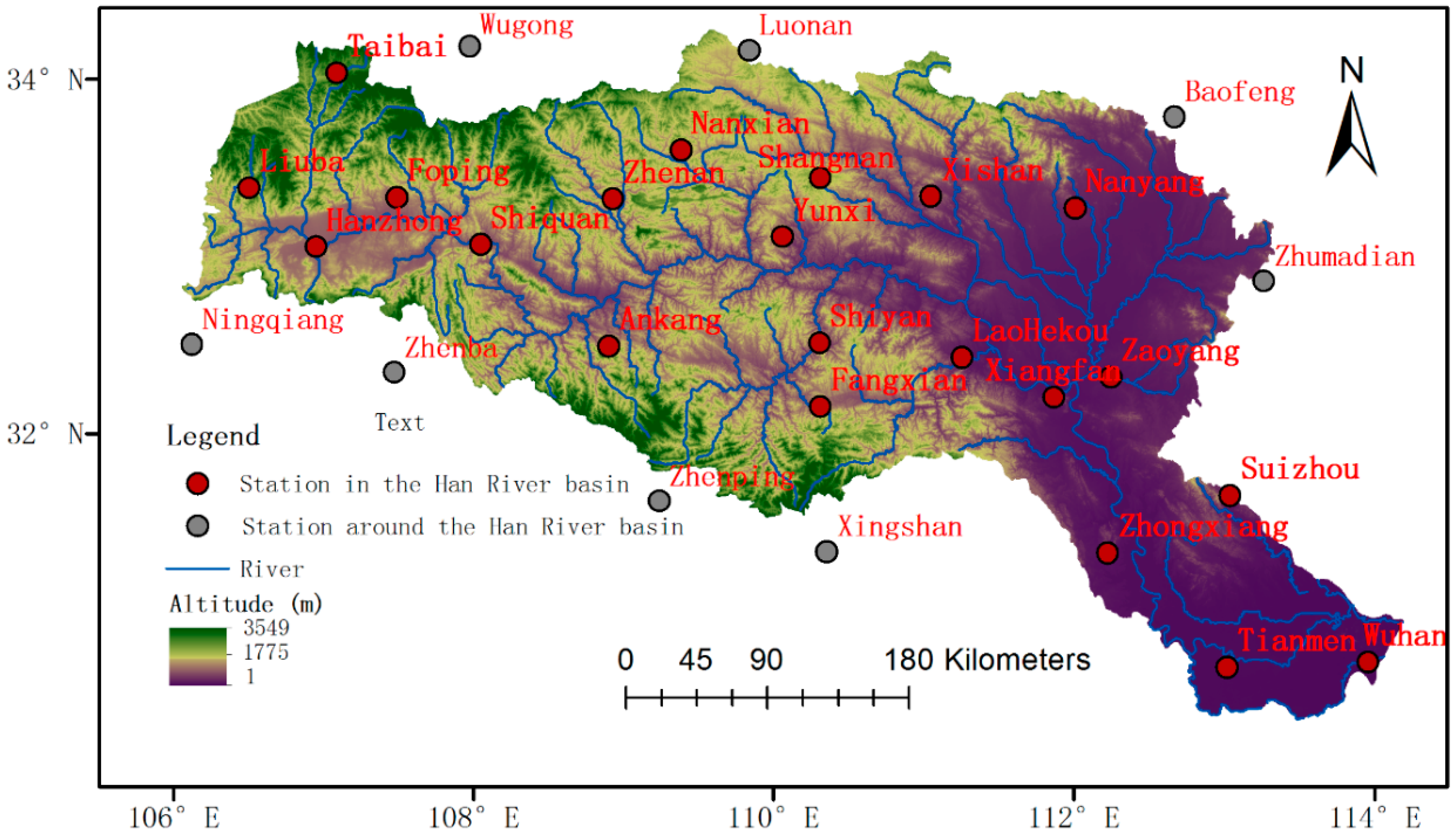
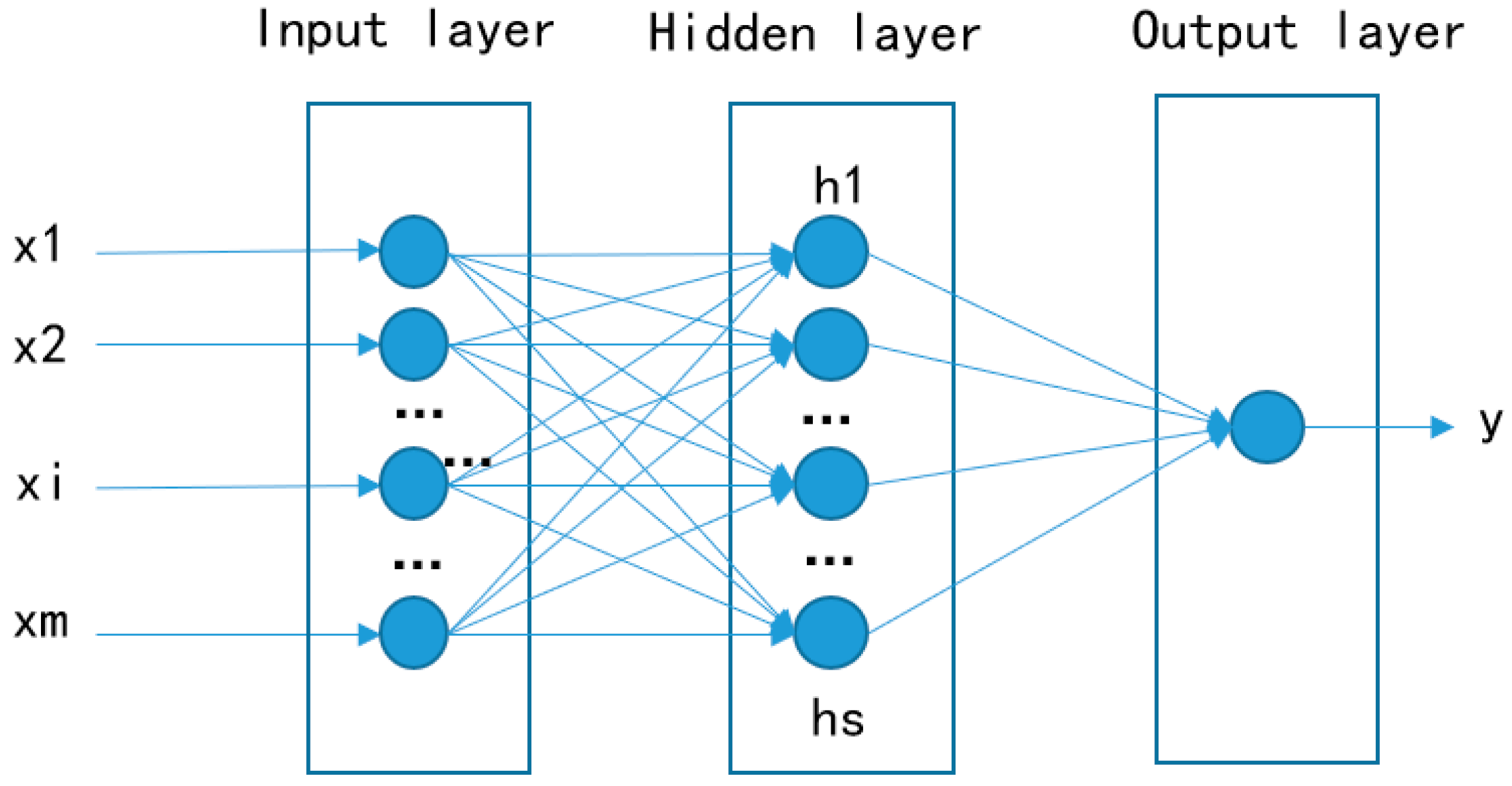
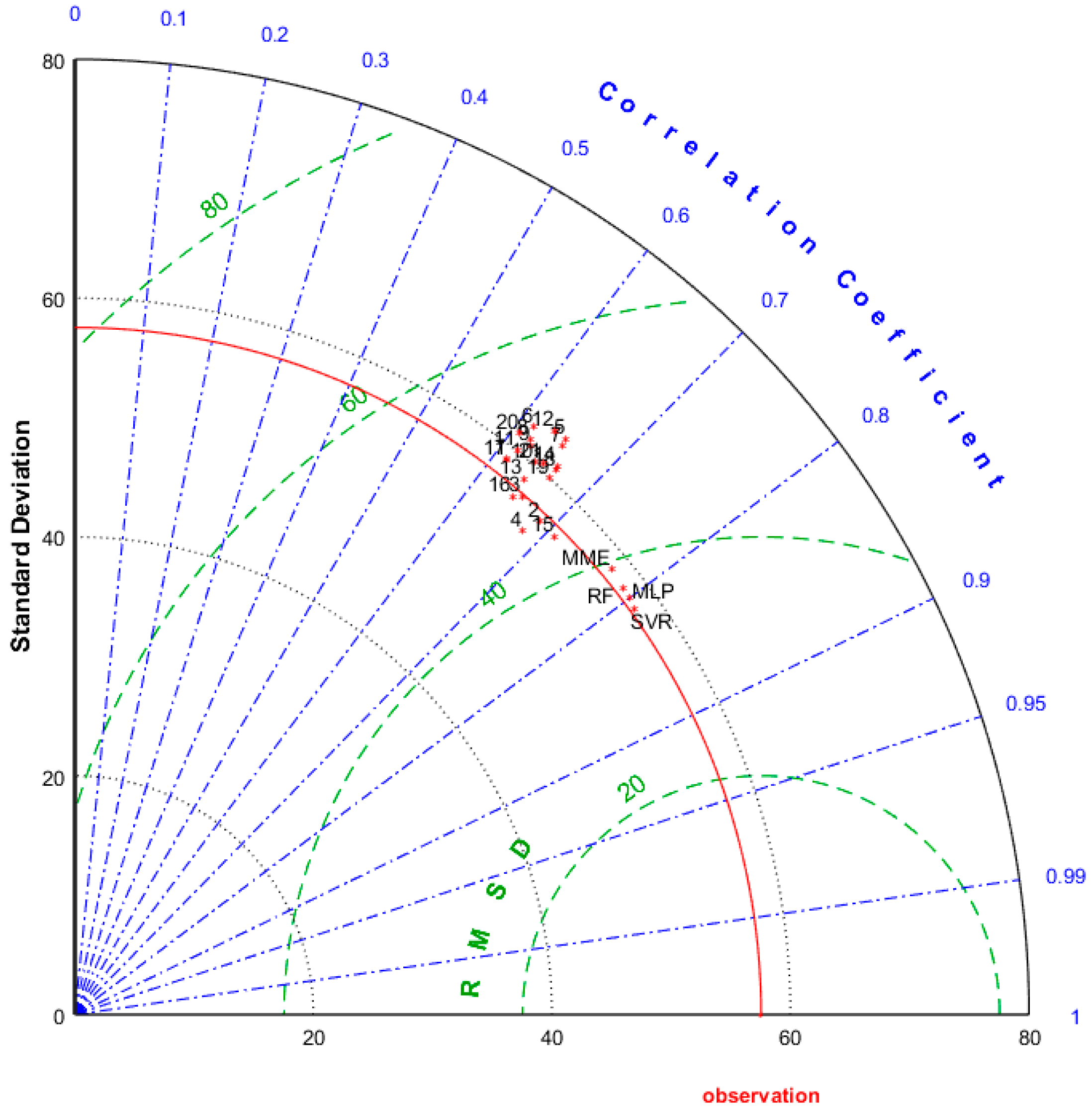
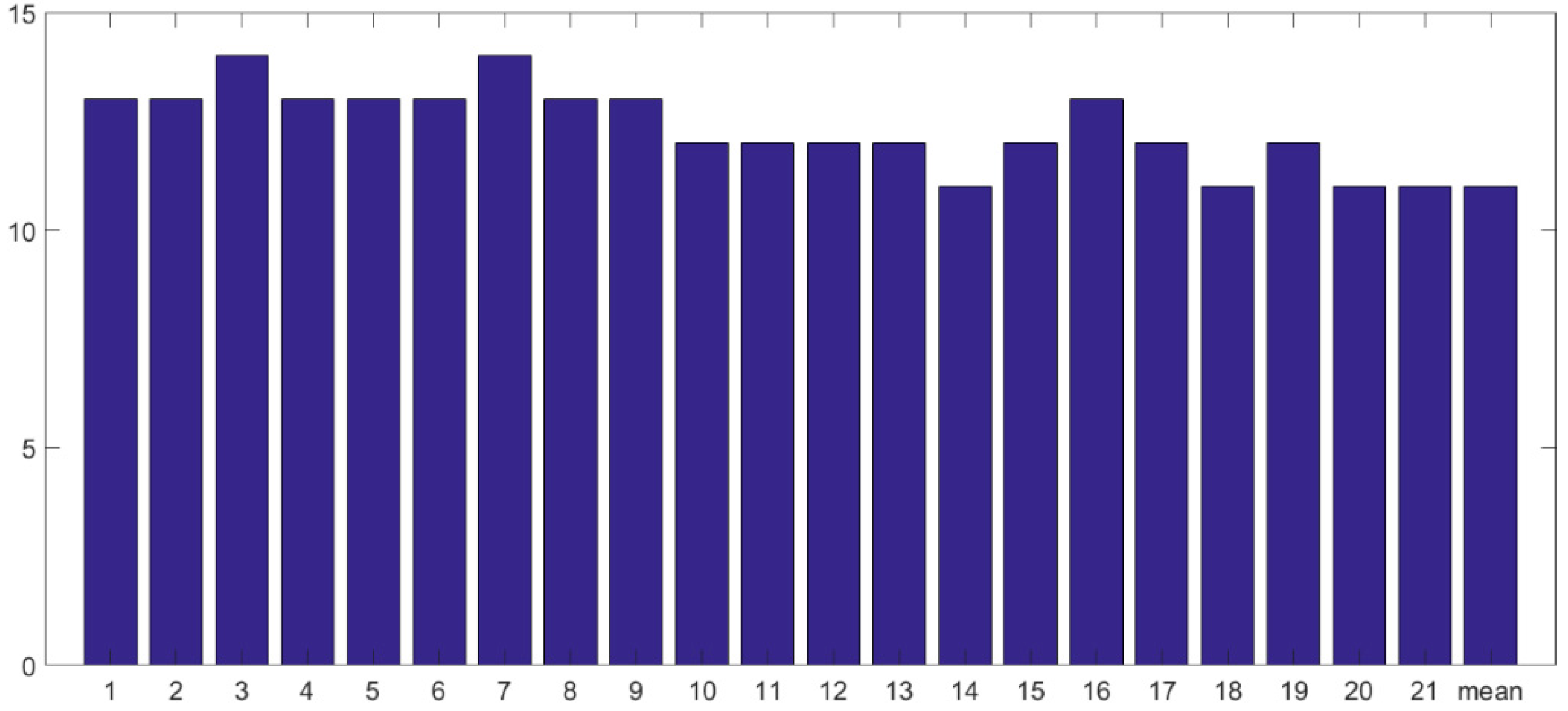
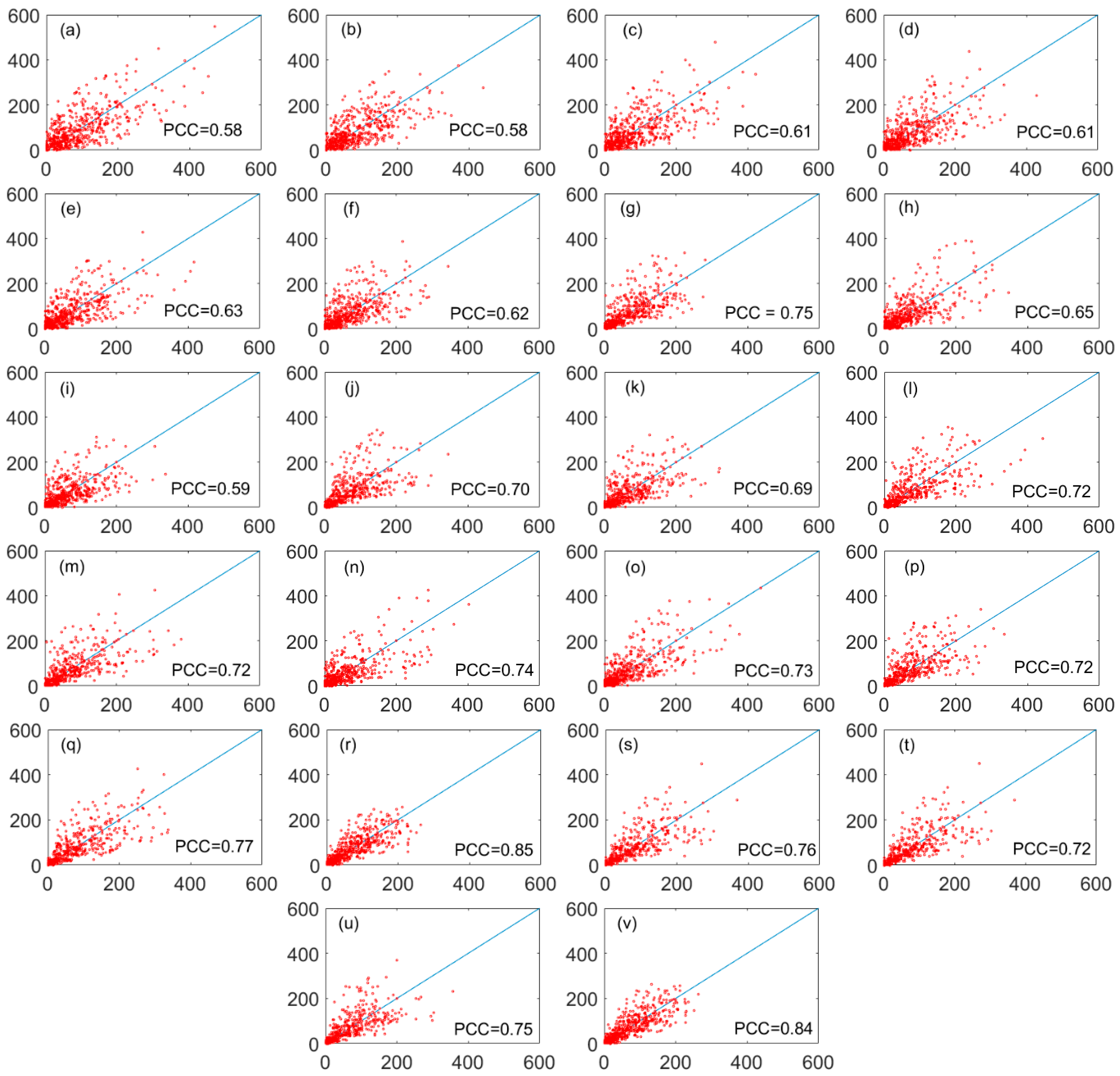

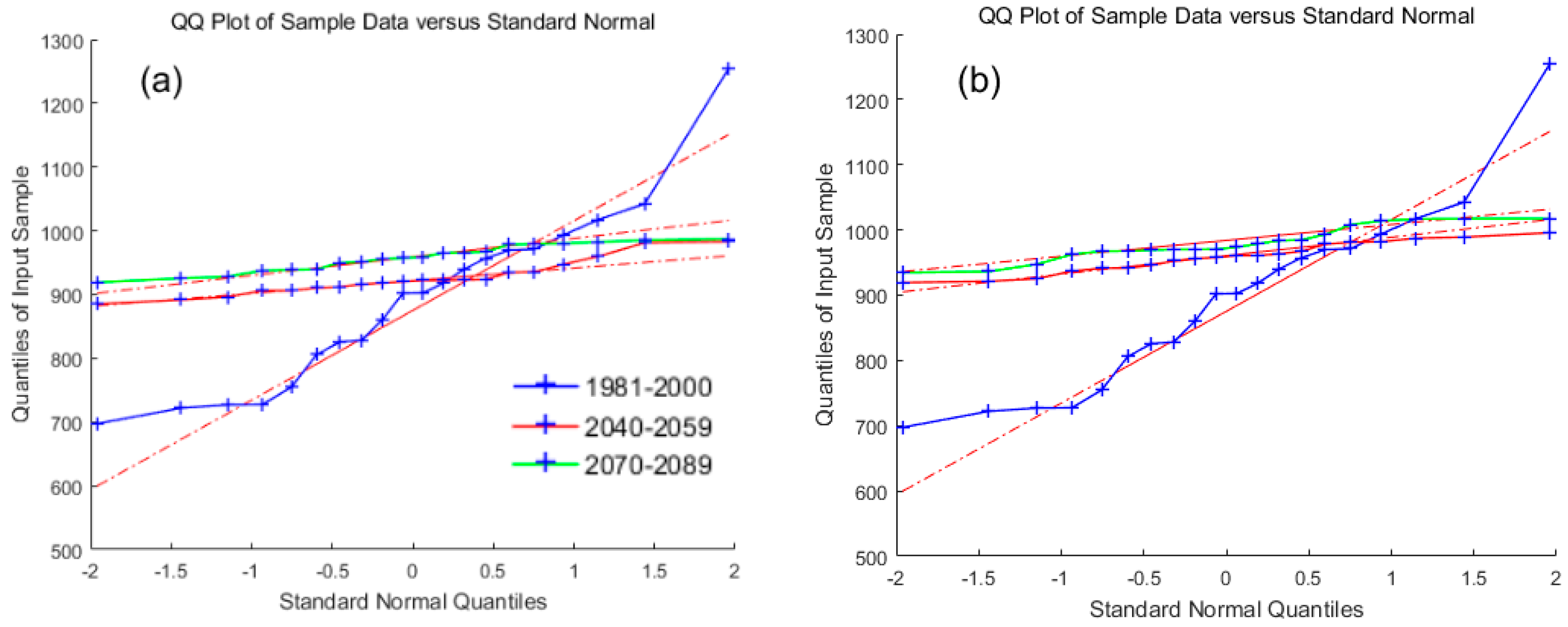
| Station | Sign | Number | Longitude | Latitude | Elevation (m) |
|---|---|---|---|---|---|
| Taibai | 57,028 | 1 | 107.19 | 34.02 | 1543.6 |
| Liuba | 57,124 | 2 | 106.56 | 33.38 | 1032.1 |
| Hanzhong | 57,127 | 3 | 107.02 | 33.04 | 509.5 |
| Foping | 57,134 | 4 | 107.59 | 33.31 | 827.2. |
| Nanxian | 57,143 | 5 | 109.58 | 33.52 | 742.2. |
| Zhenan | 57,144 | 6 | 109.09 | 33.26 | 693.7. |
| Shangnan | 57,154 | 7 | 110.54 | 33.32 | 523 |
| Xishan | 57,156 | 8 | 111.3 | 33.18 | 250.3 |
| Nanyang | 57,178 | 9 | 112.29 | 33.06 | 129.2 |
| Shiquan | 57,232 | 10 | 108.16 | 33.03 | 484.9 |
| Ankang | 57,245 | 11 | 109.02 | 32.43 | 290.8 |
| Yunxi | 57,251 | 12 | 110.25 | 33 | 249.1 |
| Fangxian | 57,259 | 13 | 110.45 | 32.03 | 426.9 |
| LaoHekou | 57,265 | 14 | 111.44 | 32.26 | 90 |
| Xiangfan | 57,278 | 15 | 112.05 | 32 | 68.6 |
| Zaoyang | 57,279 | 16 | 112.45 | 32.09 | 125.5 |
| Zhongxiang | 57,378 | 17 | 112.34 | 31.1 | 65.8 |
| Suizhou | 57,381 | 18 | 113.2 | 31.37 | 116.3 |
| Xiaogan | 57,482 | 19 | 113.57 | 30.54 | 25.5 |
| Tianmen | 57,483 | 20 | 113.08 | 30.4 | 31.9 |
| Wuhan | 57,494 | 21 | 114.03 | 30.36 | 23.6 |
| Luonan | 57,057 | \ | 110.09 | 34.06 | 963.4 |
| Zhumadian | 57,290 | \ | 113.55 | 32.56 | 82.7 |
| Baofeng | 57,181 | \ | 113.03 | 33.53 | 136.4 |
| Wugong | 57,034 | \ | 108.13 | 34.15 | 447.8 |
| Zhenping | 57,343 | \ | 109.32 | 31.54 | 995.8 |
| Xingshan | 57,359 | \ | 110.44 | 31.21 | 336.8 |
| Zhenba | 57,238 | \ | 107.54 | 32.32 | 693.9 |
| Ningqiang | 57,211 | \ | 106.15 | 32.5 | 836.1 |
| RCP | Description |
|---|---|
| RCP4.5 | Radiative forcing increased to 4.5 W/m2 (~650 ppm CO2 -eq) by 2100 |
| RCP8.5 | Radiative forcing is stable at 8.5 W/m2 (~1370 ppm CO2 -eq) by 2100 |
| Model | Number | Country and Institution |
|---|---|---|
| ACCESS1-0 | 1 | Commonwealth Scientific and Industrial Research Organization and Bureau of Meteorology, Australia |
| BCC-CMS1-1 | 2 | Beijing Climate Center, China |
| BNU-ESM | 3 | Institute of global change and Earth System Sciences, Beijing Normal University, China |
| CanESM2 | 4 | Canadian Centre for Climate Modelling and Analysis, Canada |
| CCSM4 | 5 | National Center for Atmospheric Research, America |
| CESM1-BGC | 6 | National Center for Atmospheric Research, America |
| CNRM-CM5 | 7 | Centre National de Recherches Meteorologiques, Centre Europeen de Recherche et Formation Avancees en Calcul Scientifique, France |
| CSIRO-Mk3-6-0 | 8 | Commonwealth Scientific and Industrial Research Organization/Queensland Climate Change Centre of Excellence, Australia |
| GFDL-CM3 | 9 | Geophysical Fluid Dynamics Laboratory, America |
| GFDL-ESM2G | 10 | Geophysical Fluid Dynamics Laboratory, America |
| GFDL-ESM2M | 11 | Geophysical Fluid Dynamics Laboratory, America |
| INMCM4 | 12 | Institute of Numerical Calculation, Russia |
| IPSL-CM5A-LR | 13 | Institut Pierre-Simon Laplace, France |
| IPSL-CM5A-MR | 14 | Institut Pierre-Simon Laplace, France |
| MIROC5 | 15 | Atmosphere and Ocean Research Institute, Japan |
| MIROC-ESM | 16 | Atmosphere and Ocean Research Institute, Japan |
| MIROC-ESM-CHEM | 17 | Atmosphere and Ocean Research Institute, Japan |
| MPI-ESM-LR | 18 | Max Planck Institute for Meteorology, Germany |
| MPI-ESM-MR | 19 | Max Planck Institute for Meteorology, Germany |
| MRI-CGCM3 | 20 | Max Planck Institute for Meteorology, Germany |
| NorESM1-M | 21 | Norway Consumer Council, Norway |
| Statistical Metric | Equation | Description | Unit |
|---|---|---|---|
| Pearson’s correlation coefficient (PCC) | n denotes the sample size; , are individual samples; , are the arithmetic mean of x and y | / | |
| Root mean squared error (RMSE) | denotes observed data; is the prediction value; n expresses the sample size | mm | |
| Relative bias (Rbias) | similar to the description of RMSE | % |
| Models | PCC | RMSE | Rbias | Models | PCC | RMSE | Rbias |
|---|---|---|---|---|---|---|---|
| 1 | 0.62 | 52.47 | −1.22 | 12 | 0.65 | 50.47 | 1.52 |
| 2 | 0.68 | 44.89 | 2.11 | 13 | 0.66 | 49.78 | 1.21 |
| 3 | 0.67 | 48.02 | 1.22 | 14 | 0.66 | 48.21 | 1.82 |
| 4 | 0.68 | 44.88 | 0.14 | 15 | 0.72 | 42.47 | −0.56 |
| 5 | 0.67 | 51.63 | 3.22 | 16 | 0.65 | 47.78 | 0.16 |
| 6 | 0.61 | 51.95 | 1.37 | 17 | 0.60 | 50.27 | 1.21 |
| 7 | 0.66 | 50.22 | 3.11 | 18 | 0.66 | 48.24 | 3.42 |
| 8 | 0.64 | 52.57 | 0.69 | 19 | 0.67 | 48.58 | 2.32 |
| 9 | 0.63 | 51.72 | 2.46 | 20 | 0.60 | 51.98 | −1.03 |
| 10 | 0.62 | 48.87 | 0.12 | 21 | 0.65 | 49.32 | 1.88 |
| 11 | 0.65 | 52.08 | 3.02 | MME | 0.75 | 36.68 | 2.32 |
| Station | MLP | SVR | RF | ||||||
|---|---|---|---|---|---|---|---|---|---|
| PCC | RMSE | Rbias | PCC | RMSE | Rbias | PCC | RMSE | Rbias | |
| 1 | 0.51 | 84.66 | −2.61 | 0.56 | 80.65 | −7.05 | 0.54 | 83.00 | 2.34 |
| 2 | 0.54 | 68.06 | −3.14 | 0.59 | 65.84 | −5.18 | 0.53 | 68.07 | 1.86 |
| 3 | 0.54 | 74.95 | −2.57 | 0.58 | 73.61 | −3.30 | 0.55 | 74.07 | 3.19 |
| 4 | 0.57 | 59.31 | −4.11 | 0.62 | 58.14 | −3.30 | 0.56 | 59.91 | −4.86 |
| 5 | 0.55 | 64.12 | −3.45 | 0.61 | 62.97 | −7.19 | 0.56 | 63.55 | −3.38 |
| 6 | 0.60 | 51.24 | −7.36 | 0.62 | 49.89 | −1.06 | 0.59 | 50.62 | 1.17 |
| 7 | 0.73 | 41.96 | −3.60 | 0.75 | 40.41 | −5.92 | 0.72 | 41.65 | 2.13 |
| 8 | 0.59 | 58.38 | −1.12 | 0.63 | 57.19 | −2.42 | 0.58 | 58.96 | −2.72 |
| 9 | 0.52 | 54.06 | −4.26 | 0.56 | 53.37 | −4.25 | 0.53 | 53.69 | 4.27 |
| 10 | 0.68 | 47.56 | 1.76 | 0.71 | 46.12 | −4.80 | 0.67 | 47.95 | 2.35 |
| 11 | 0.63 | 48.70 | −3.74 | 0.67 | 47.09 | −5.77 | 0.64 | 48.58 | −4.58 |
| 12 | 0.67 | 56.96 | −4.64 | 0.71 | 55.08 | −6.14 | 0.67 | 57.14 | −2.76 |
| 13 | 0.69 | 53.46 | −5.60 | 0.72 | 51.67 | −5.62 | 0.66 | 54.88 | −3.79 |
| 14 | 0.58 | 63.83 | 1.36 | 0.82 | 47.74 | −3.30 | 0.55 | 65.62 | −4.21 |
| 15 | 0.68 | 52.97 | −4.87 | 0.72 | 50.36 | 2.73 | 0.67 | 53.74 | 0.89 |
| 16 | 0.69 | 46.58 | −5.55 | 0.72 | 45.73 | −4.73 | 0.68 | 47.31 | −2.55 |
| 17 | 0.73 | 53.25 | −2.73 | 0.76 | 52.30 | −5.35 | 0.73 | 53.69 | −3.39 |
| 18 | 0.66 | 52.19 | −0.51 | 0.86 | 37.64 | −3.86 | 0.65 | 52.63 | −4.22 |
| 19 | 0.72 | 53.05 | −6.64 | 0.75 | 50.61 | −5.25 | 0.72 | 52.99 | 1.09 |
| 20 | 0.67 | 40.75 | −3.24 | 0.71 | 38.81 | −1.36 | 0.67 | 40.90 | −3.89 |
| 21 | 0.75 | 42.33 | −2.74 | 0.77 | 41.21 | −3.72 | 0.75 | 41.98 | 1.26 |
| Mean | 0.77 | 35.78 | −1.82 | 0.81 | 34.24 | −2.48 | 0.78 | 36.21 | −2.21 |
| Station | PCC | RMSE | Rbias | Station | PCC | RMSE | Rbias |
|---|---|---|---|---|---|---|---|
| 1 | 0.58 | 79.88 | −1.04 | 12 | 0.72 | 55.23 | −1.34 |
| 2 | 0.58 | 60.23 | −0.33 | 13 | 0.72 | 50.04 | −0.38 |
| 3 | 0.61 | 69.29 | 0.26 | 14 | 0.74 | 45.68 | −0.04 |
| 4 | 0.63 | 56.19 | −1.77 | 15 | 0.73 | 48.79 | 0.32 |
| 5 | 0.63 | 60.88 | −1.39 | 16 | 0.72 | 45.38 | −1.02 |
| 6 | 0.62 | 48.78 | −0.05 | 17 | 0.77 | 50.80 | −0.18 |
| 7 | 0.75 | 39.35 | −1.21 | 18 | 0.85 | 36.89 | −0.12 |
| 8 | 0.65 | 55.11 | −2.04 | 19 | 0.76 | 49.68 | −1.23 |
| 9 | 0.59 | 50.13 | −0.79 | 20 | 0.72 | 38.18 | −0.09 |
| 10 | 0.70 | 46.44 | −1.08 | 21 | 0.77 | 40.09 | −0.68 |
| 11 | 0.69 | 45.84 | −0.66 | mean | 0.84 | 33.78 | −0.04 |
| Model | PCC | RMSE | Rbias |
|---|---|---|---|
| MME | 0.75 | 36.68 | 2.32 |
| MLP | 0.77 | 35.78 | −1.82 |
| SVR | 0.81 | 34.24 | −2.48 |
| RF | 0.78 | 36.21 | −2.21 |
| SVR_QM | 0.84 | 33.78 | −0.04 |
| Station | RCP4.5 | RCP8.5 | Station | RCP4.5 | RCP8.5 | ||||
|---|---|---|---|---|---|---|---|---|---|
| Trend | Z | Trend | Z | Trend | Z | Trend | Z | ||
| 1 | 1.68 | 1.96 * | 1.85 | 3.11 ** | 12 | −1.14 | −2.78 ** | 0.19 | 0.82 |
| 2 | −1.02 | 0.15 | −0.31 | 1.04 | 13 | 0.52 | 1.29 | 1.12 | 1.07 |
| 3 | 1.31 | 1.97 * | 1.54 | 3.32 ** | 14 | −0.42 | −2.30 * | 0.45 | 2.17 * |
| 4 | 1.08 | 2.69 ** | 1.22 | 3.01 ** | 15 | 1.27 | 3.58 ** | 1.13 | 4.94 ** |
| 5 | −0.14 | −1.24 | 0.43 | 0.46 | 16 | 1.59 | 2.65 ** | 1.66 | 1.99 * |
| 6 | −0.33 | −2.2 ** | −0.07 | 0.98 | 17 | 0.67 | 2.73 ** | 0.99 | 3.80 ** |
| 7 | −1.18 | −0.09 | 1.49 | 2.28 * | 18 | 0.92 | 0.44 | 1.25 | 1.14 |
| 8 | 0.55 | 2.11 * | 0.79 | 1.52 | 19 | 1.23 | 2.02 * | 1.01 | 2.19 * |
| 9 | 1.14 | 2.62 ** | 0.87 | 4.14 ** | 20 | 1.57 | 1.29 | 1.47 | 1.53 |
| 10 | 1.71 | 1.23 | 2.01 | 0.05 | 21 | 1.01 | 1.43 | 1.10 | 4.21 ** |
| 11 | 1.85 | 3.31 ** | 1.15 | 2.13 * | Mean | 0.58 | 4.34 ** | 0.85 | 7.43 ** |
| Station | RCP4.5 | RCP8.5 | Station | RCP4.5 | RCP8.5 | ||||
|---|---|---|---|---|---|---|---|---|---|
| 2040–2059 | 2070–2089 | 2040–2059 | 2070–2089 | 2040–2059 | 2070–2089 | 2040–2059 | 2070–2089 | ||
| 1 | 3.20 | 4.77 | 0.13 | 4.30 | 12 | −5.00 | 1.05 | 0.32 | 5.28 |
| 2 | 6.89 | 8.91 | 9.48 | 14.00 | 13 | −5.40 | 0.20 | −0.16 | 5.46 |
| 3 | 9.93 | 11.75 | 9.77 | 14.12 | 14 | 5.39 | 10.92 | 11.73 | 15.27 |
| 4 | 11.52 | 14.59 | 15.26 | 19.48 | 15 | −5.38 | 0.46 | −0.45 | 3.44 |
| 5 | 13.94 | 16.72 | 16.61 | 20.69 | 16 | 5.09 | 12.01 | 10.28 | 15.52 |
| 6 | 18.04 | 22.69 | 24.07 | 27.74 | 17 | −11.29 | −5.83 | −6.96 | −2.33 |
| 7 | 17.23 | 23.37 | 24.11 | 30.01 | 18 | −8.71 | −2.76 | −4.26 | −0.16 |
| 8 | 18.01 | 22.48 | 23.89 | 27.43 | 19 | −12.04 | −7.39 | −10.72 | −5.31 |
| 9 | 14.10 | 19.68 | 20.85 | 24.79 | 20 | 13.11 | 20.70 | 18.11 | 23.56 |
| 10 | 13.57 | 20.84 | 20.44 | 26.99 | 21 | −3.17 | 2.38 | −0.99 | 4.63 |
| 11 | 6.29 | 13.18 | 11.98 | 17.02 | Mean | 3.54 | 5.12 | 7.44 | 9.52 |
© 2019 by the authors. Licensee MDPI, Basel, Switzerland. This article is an open access article distributed under the terms and conditions of the Creative Commons Attribution (CC BY) license (http://creativecommons.org/licenses/by/4.0/).
Share and Cite
Xu, R.; Chen, Y.; Chen, Z. Future Changes of Precipitation over the Han River Basin Using NEX-GDDP Dataset and the SVR_QM Method. Atmosphere 2019, 10, 688. https://doi.org/10.3390/atmos10110688
Xu R, Chen Y, Chen Z. Future Changes of Precipitation over the Han River Basin Using NEX-GDDP Dataset and the SVR_QM Method. Atmosphere. 2019; 10(11):688. https://doi.org/10.3390/atmos10110688
Chicago/Turabian StyleXu, Ren, Yumin Chen, and Zeqiang Chen. 2019. "Future Changes of Precipitation over the Han River Basin Using NEX-GDDP Dataset and the SVR_QM Method" Atmosphere 10, no. 11: 688. https://doi.org/10.3390/atmos10110688
APA StyleXu, R., Chen, Y., & Chen, Z. (2019). Future Changes of Precipitation over the Han River Basin Using NEX-GDDP Dataset and the SVR_QM Method. Atmosphere, 10(11), 688. https://doi.org/10.3390/atmos10110688





